Thursday, May 26
We've started to soak wine bottles in hopes of saving the labels, knowing that it's time to start recycling our mantletop collection. The first batch from Domaine du Trésor comes off easily. But now the Beauvignac bottles (from the Picpoul cave cooperative) are not cooperating. But our plan B is to photograph the bottles before removing labels (thanks, Clark, for that suggestion).

We have a breakfast of French toast and then go to the market for fruits and vegetables. As we're down to our last few dinners here, we must empty the freezer, refrigerator and cupboard over the next few days. Seems hard to believe that we leave on Tuesday. My plan would be to hang out at the apartment for the day, starting the sorting and packing process. But Dave has other plans. It's another hot day in Thézan and I'm still drained from yesterday's adventures in the heat of Montpelier.
So at noon, armed with sandwiches and cold drinks, we head out for Peyre which is only 7 km from Millau. As it turns out the village has an awesome view of the Millau viaduct from it's Tarn river location. It must have been interesting to live there during the building of the viaduct. They would have had a birds-eye view of all the construction activities.

Peyre (pronounced Pair-re) is another village from our updated copy of the Beautiful Villages of France book. It clings to the cliff side above the Tarn river on the west side of the viaduct, opposite the direction one takes to get to the Gorges du Tarn area.

We have learned from our book that to become a Beautiful Village, a village must have no more than 2000 inhabitants, have at least 2 monuments, and agree as a town to participate in the organization. Those criteria met, the village makes application and then receives a site visit from a Beautiful Villages committee which determines the village's status on 27 other criteria, including making the town welcome to visitors. Towns can be declassified if they don't maintain their adherence to these criteria. We have visited all of the beautiful villages that are easy to get to from Béziers and they have all been spectacularly beautiful and interesting in one way or another.
Peyre proves no different. As the town clings to the side of a cliff, the parking is down at the river level and a bit outside the town. While there are a couple of "drivable" streets in town and we see some garages that you could get a car into, there would be no room for even one tourist car to park.
We walk up the steep paths to the top where there is a fortified, now-abandoned church built into the side of an overhanging cliff. There is no town per se, at least not anymore, just a collection of houses, the church and a former community bake oven the shade of whose benches we use as our lunch picnic spot.

It turns out that our plan to drive into the Causse du Larzac is a good one as it is a hazy, mostly cloudy day, the temperature on the Causse is a modest 24 (about 78) and there is a cool breeze.
We look into the church which was abandoned and sold shortly after being taken over by the state as "public goods" in the French Revolution. (You might remember that the French revolutionary government took over all the churches including their buildings, lands and assets as belonging to the public. These buildings and assets were then sold to private citizens, usually at auction. The money raised by selling this church was used to build a "new" church in the valley.)
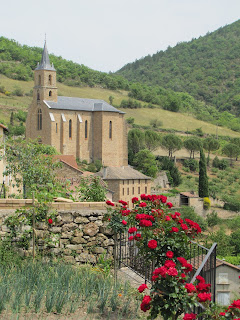
New church in the valley
The troglodyte (a word used to describe buildings that are built into caves) church is surprisingly devoid of any church-like characteristics and what we see was clearly as much fort as church. But the outside is very interesting. Built under the overhanging rock, construction of a facade and tower were all that was required. Since it was also a fortress, there are few windows which are small and empty of glass. You can still see the arrow slits and murder holes built at places in the tower.


We wander a couple other alleyways, taking photos, marveling at the views from the terrasses of the houses. Rather spectacular scenery for aperos, we think.


There seems to be one business in the village, a potter. She explains her firing techniques (Raku and some sort of crystallization process that I don't understand). I ask her about the Beautiful Villages book and if the French use it. She says no, mostly non-native tourists. I buy a small pitcher of the crystalline type and we head out of town.
We had noticed an information sign about the Millau viaduct as we crossed into town and decide to follow that. It leads us across a small bridge and up around the shoulder of the other bank of the Tarn and eventually to a rather large visitor center built to explain the viaduct. There are some great views of the viaduct, although the photos will not do them justice due to the hazy conditions. A pretty neat discovery. Obviously, it is on the tourist and bus route as there are lots of folks milling around.

As it is only 2:30, we decide to continue our explorations by following part of the "route des templiers et hospitaliers". This will lead us to two of the towns that were part of the same commanderie as La Couvertoirade.
The first town is called La Cavalerie. The Templiers, and after them the Hospitaliers, exploited the agricultural resources through the work of the local peasants. A commanderie was founded for the Templiers in the 12th century in which the town developed. It was fortified by the Hospitaliers in the 15th century. These fortifications were attacked multiple times during the wars of religion and the fortress had significant damage as a result. Today one sees the restored bourg or fortress part of the town. It's 4 towers were all lowered to the height of the ramparts at some point and the town is making great efforts to make the center of the bourg a pleasant neighborhood.

As a result of the devastation in past history, the insides of the bourg are more open than you might expect and there is a pleasant square in the center that has benches and planters where I do needlework while Dave explores the rest of the bourg.

It's not large, clearly some houses are original with modern repairs. In other places, where there was only rubble, the land has been cleared and a new house built in keeping with the architecture of the bourg. There are still some opportunities for improvement as we note a rather large house with prime location against the inner walls of the bourg that is rather in need of TLC and is for sale as well. We think it would make a great B&B
We head out for our next town, St Eulalie de Cernon. But on the map, I spot what appears to be a look out point on a dead-end road along the way. We decide to see if we can find this viewpoint. As we head down a one lane blacktop road amidst fields of wheat and barley, we wonder if we are on the right road. But we see tall towers of communications equipment ahead and continue over the last 500 meters on a bumpy gravel tractor path. In the end we are rewarded by views over the valleys several hundred meters below us. We can even see the town of St Eulalie below us.


We notice that this Causse de Larzac seems to have soil that can grow crops as we see large (for France) fields of hay (already cut and rolled in the first haying of the season) and fields of grasses and grains (wheat and barley). This area looks richer than the tops of other Causses we've traveled. When I look on the Internet, I find that the Causse of Larzac has a more southerly orientation than the others and has indentations (little valleys) where the erosion has deposited soils that allow for the agriculture we see. But for the most part it is the same limestone we've been seeing elsewhere that is inhospitable to crops. The view is expansive, but hazy on this cloudy day. We finally make the U-turn Olga has been begging us for and she is happy now to be sending us on the correct path to St Eulalie. "Please make a U-turn, if possible" she croons in her impeccably unperturbed British accent.
Like all these small villages, we are directed to a parking lot outside the village. Like La Cavalerie, this village is located on a relatively flat area near the Cernon river. It isn't on top of the Causses, but 300 meters below, so seems to be sitting in a valley, although this valley isn't at the bottom of the Causse. Again, we enter a walled village, although this one has lots of opportunities for improvement. It seems rather run down and in need of sprucing up in most spots. Again, it seems un-touristy, although there is a busload of French senior citizens in the town. They are mostly congregated at the bar-tabac on the square, but they are on their way out as we are coming in, so we pretty much have the town to ourselves. (It is after all 5 PM)
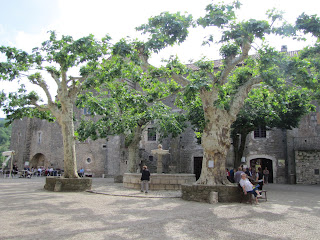
St Eulalie de Cernon was the administrative center for the Commanderie that included La Couvertoirade and La Cavalerie and also the home of the Commandeur. It's history is much as that of La Cavalerie - begun by the Templiers in the 12th century, taken over by the Hospitaliers on the disbanding of the Templiers, fortified by the Hospitaliers during the wars of religion, sacked during the wars of religion and again during the French Revolution and sold off in parcels at auction by the post-revolution government. Along with its outlying towns of La Couvertoirade and La Cavalerie, this Commanderie was the richest and most powerful Templar / Hospitalier commanderie in Southern France. It was responsible for supplying a great deal of money and resources to their Jerusalem counterparts.
What saves this town (now just 834 people) is that the commanderie became a resort for the 16th century commandeurs and was spruced up in several significant ways that still exist. The square, the commanderie itself, and the church were all changed during this period. Like La Couvertoirade, there is an audio guide tour of the Commanderie and church which we decide to do in the hour left before the 6 PM closing time.
The church has a strange entry, a baroque door added during the Renaissance that pierces what was once the apse. The commander of the time changed the orientation of the church, moving the altar to the opposite end of the nave. This in order to create a door where the villagers could enter the church from the square rather than using the door from the courtyard of the commanderie building.

The church inside is Romanesque with added side chapels over the centuries.
We next enter the courtyard of the Commanderie where the services necessary for life inside were carried out. Stables, kitchens, and other services would have been carried out in this inner courtyard.

As we explore rooms upstairs, we see various commanderie rooms. One of these is covered with rich murals from the Renaissance improvements. The monks' dormitory shows how their sleeping quarters would have been lined with pallets of straw. The refectory was redone in the Renaissance as well and made into two floors with reception rooms on the upper floor.
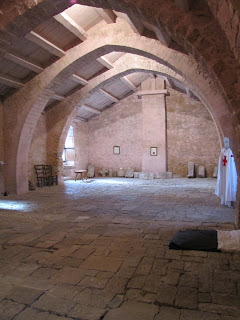
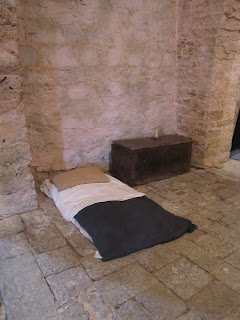

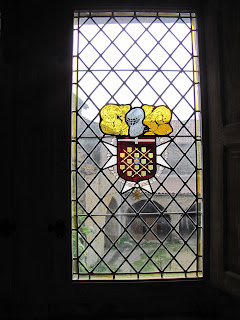
The guide, as in La Couvertoirade, is worth the extra Euro we paid for its use. But as the town closes up, we leave as well, making our way back to the A75 for the fast way home. Along the way to the A75, we see several rather large herds of sheep grazing in the dusk. We stop for photos and I also finally get a photo of my sheep crossing sign I've been wanting.
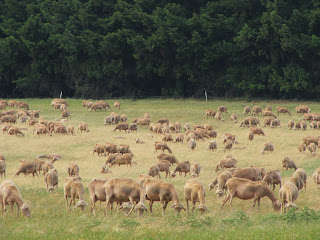
Roquefort cheese, anyone?

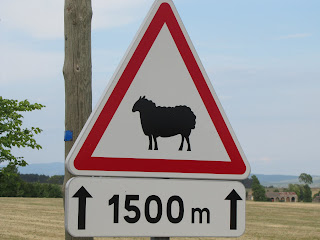
As we head down the highway, I note that the greens of spring are changing to browns and tans, especially where the grass has been cut along side of the roads. The heat of the week has taken its toll on the plant life. As well there are now fields and highway edges of grasses turned the color of straw and waving in the breezes.

The yellows of the genêts are still visible, and at certain altitudes we still see fields of them but up close we can see that they are losing their intensity of bloom. There are still the occasional fields of poppies, but they are less intense in color than earlier. We are definitely moving into the summer season.
